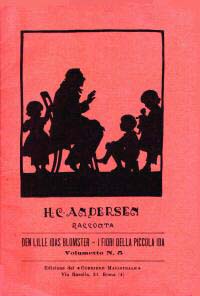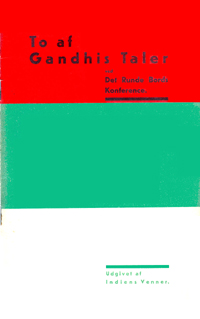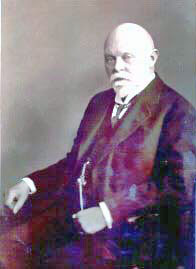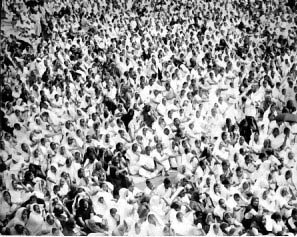The Danish Peace Academy
GANDHI AND NORDIC COUNTRIES
Edited by E. S. Reddy - EReddy@aol.com and Holger Terp


Ellen Hørup and Mohandas Gandhi |
By Holger Terp

INTRODUCTION |
The Danish journalist Ellen Hørup (1871-1953) wrote more than 600 feature articles and editorials, and more than 300 shorter articles in newspapers, magazines and books about international politics, armament and disarmament, and imperialism. Her first work was about Gandhi and his non-violent struggle against British imperialism in India. Later she wrote against fascism and nazism, against totalitarian goverments as a whole, and militarism, including NATO. Most of her work was done in the thirties and forties, which made it natural for her to write about subjects such as the Spanish Civil War, The League of Nations and political as well as religious refugees (long before Amnesty International).
During the German occupation of Denmark, when she was unable to write about foreign political matters, she set her mind upon writing about another oppressed group, children. She became a strong critic of Danish public childcare, an effort for which she is not completely forgotten. In fact, some people still remember her with gratitude, and a new magazine about children’s conditions in Denmark is named after her, “ELLEN”.
Ellen Hørup was, in many ways, a person ahead of her time. She wrote not only about the subjects already mentioned, she also wrote about agriculture and pollution. Being one of the first female foreign policy journalists in Denmark and internationally, she also took great interest in womens’ liberation and wrote a great deal about it. Her main focus was, however, her peace work. She was a cosmospolite. Not only did Ellen Hørup speak and write in Danish, but she also spoke and wrote exellently in English, Italian, German, Russian and French.
 Ellen Hørup was a member of Danish and
international peace groups. However, she never was a member of any
political party or religioius group, even though she had friends in
unexpected places. Ellen Hørup was a “grassroots”
50 years before the word was invented. (1)
Ellen Hørup was a member of Danish and
international peace groups. However, she never was a member of any
political party or religioius group, even though she had friends in
unexpected places. Ellen Hørup was a “grassroots”
50 years before the word was invented. (1)
She was the daughter of the famous Danish anti-militarist, journalist and politican Viggo Hørup (1841-1902). (2) In October 1884 he founded the daily “Politiken”, which slowly grew to become one of the biggest newspapers in the country. The shares in “Politiken”, which she had inherited from her parents, made her economically independent.
After the death of her mother, in late 1923, Ellen Hørup
divorced her husband and settled in Rome.  After translating some of Hans Christian Anderseen's fairy
tales into Italian in 1927; she made the acquaintance of
Gandhi’s non-violent fight for freedom and decided to carry on
the journalistic work of her father by describing the activities of
The Congress Party as well as the activities of Mahatma (as he was
called) Gandhi. She visited Gandhi and worked for him in the late
1920s together with other female friends: the world famous Danish
painter, ceramist and designer Cathinca Olsen and the then equally
famous Norwegian singer Bokken Lasson. Both worked in the
Friends of India Society in Copenhagen and Oslo.
After translating some of Hans Christian Anderseen's fairy
tales into Italian in 1927; she made the acquaintance of
Gandhi’s non-violent fight for freedom and decided to carry on
the journalistic work of her father by describing the activities of
The Congress Party as well as the activities of Mahatma (as he was
called) Gandhi. She visited Gandhi and worked for him in the late
1920s together with other female friends: the world famous Danish
painter, ceramist and designer Cathinca Olsen and the then equally
famous Norwegian singer Bokken Lasson. Both worked in the
Friends of India Society in Copenhagen and Oslo.

INTERNATIONAL PEACE NEWS |
Despite the fact that her father had taken part in establishing “Politiken”, and she was a share holder and member of the board (from 1933 to 1949), as a part of the Danish establisment, the paper was not always happy to publish her controversial articles and analyses of international politics. But the paper did it in spite of a growing political disagreement. Throwing out the daughter of the founder and late leading journalist in Scandinavia would not look too good in the public’s eyes.

The International Committee for India |
 In order to get her pacifist information out to a
larger international public, as well as in order to be better
informed herself, she moved to Geveva in 1933. Here, before moving,
in October 1932, she established “The
International Committee for India” and in 1935, the
news agency “Journal des Archives”. (3) “The
International Committee for India” held at least three
international conferences in 1932 and 1933 in Geneva. Some of the
organizations and individuals which were connected to the Committee
were: “The Friends of India Societies” in London,
Copenhagen and Oslo, “The Indian Conciliation Group”,
London, “The Womens’ International League for Peace and
Freedom”, Alice Paul, Agathe Harrison, Edmond Privat, Dorothy
Detzer, Edit Pye, Margerith Cousins, Sidney Strong, Magdalene
Rolland - the sister of Romain Rolland - and Emmeline
Pethick-Lawrence. (Some of the women mentioned here were supporters
of the Suffragette movement and members of “The Womens’
International League for Peace and Freedom”. Others were
“Friends”).
In order to get her pacifist information out to a
larger international public, as well as in order to be better
informed herself, she moved to Geveva in 1933. Here, before moving,
in October 1932, she established “The
International Committee for India” and in 1935, the
news agency “Journal des Archives”. (3) “The
International Committee for India” held at least three
international conferences in 1932 and 1933 in Geneva. Some of the
organizations and individuals which were connected to the Committee
were: “The Friends of India Societies” in London,
Copenhagen and Oslo, “The Indian Conciliation Group”,
London, “The Womens’ International League for Peace and
Freedom”, Alice Paul, Agathe Harrison, Edmond Privat, Dorothy
Detzer, Edit Pye, Margerith Cousins, Sidney Strong, Magdalene
Rolland - the sister of Romain Rolland - and Emmeline
Pethick-Lawrence. (Some of the women mentioned here were supporters
of the Suffragette movement and members of “The Womens’
International League for Peace and Freedom”. Others were
“Friends”).
 “The
International Committee for India” published the magazine
“Indian Press”, 1934-1935. The peace news agency
published the now extremely rare, and to my knowledge, never since
quoted magazines “Letter from Geneva” and
“Journal des Archives” in English, French and German.
In 1930, in Copenhagen, she had already formed the organization and
magazine “Indiens Venner” / Friends of India Society. At
the time there were similar pro-Gandhi organizations which
supported the Indian nationalist struggle in Norway, Sveden,
England, Belgium, France, Bulgaria, Japan and U.S.A., as well as
other countries. These organizations and their magazines are mostly
forgotten today.
“The
International Committee for India” published the magazine
“Indian Press”, 1934-1935. The peace news agency
published the now extremely rare, and to my knowledge, never since
quoted magazines “Letter from Geneva” and
“Journal des Archives” in English, French and German.
In 1930, in Copenhagen, she had already formed the organization and
magazine “Indiens Venner” / Friends of India Society. At
the time there were similar pro-Gandhi organizations which
supported the Indian nationalist struggle in Norway, Sveden,
England, Belgium, France, Bulgaria, Japan and U.S.A., as well as
other countries. These organizations and their magazines are mostly
forgotten today.
The Danish “Friends of India Society” lasted from November 1930 to around 1938 and had some 250 members. (4) Among the members were Danish missionaries who had travelled and lived in India for a long time. Among them were Anne Marie Petersen, the headmaster of “The Indian National School”, Porto Novo; Gandhi’s “dear child” Ester Færing (Menon), Johan Bittermann and his wife - who lived in India for 42 year and the Swedish missionary Mrs. Karlmark from “The Swedish Church Mission”. Besides the stories of the Indian liberation movement, the magazine also carried cultural and religious articles, thus painting a broader picture of India than the ordinary magazines of the peace movements of the time.
MAHATMA GANDHI
Ellen Hørup admired Gandhi whom she visited and worked for in the winter of 1929/30 and again in the winter of 1930/31 when she followed him and worked for him during his journey from India to the Round Table Conference in London. She also corresponded with Gandhi through the years. In one of the first letters she wrote to him from Rome, dated May 2, 1929, she writes:
 |
|
|
“In Denmark we have a Socialist-Radical ministry. Two of my friends have been ministers, one of foreign affairs, another of justice (Minister of Foreign Affairs P. Munch and former Prime Minister and Minister of Justice Carl Th. Zahle), so I hope that there shall be no difficulties with my passport for India in a year and a half. My first article about India has been published. I send you the number of the paper although it is in Danish, because I remember your expression when you asked me “what I was doing in Rome”. My second article is called “Mahatma Gandhi and his Ashram“. It is already mailed and will be published this month. The Danish ministry is a disarmament ministry in accordence with my father’s ideas”. (5)
On June 6th 1931 Ellen Hørup wrote to Bapuji, Gandhi’s nickname among friends:
“Yes it would have been nice, if we could have met each other oftener. But I don’t complain. I went to most of your meetings, and I attended more than twenty times to the evening prayer. But I always felt, that I had no right to take your time…”
“I am on my way back to Denmark, where I shall let my friends make me a member of the board of my paper Politiken. During this year I shall stay in Copenhagen and try to make the paper a little less yellow and a little more truthful. If I can do nothing, I must make “The Friends of India” larger and broader and leave the others alone”. (6)
In December 1931 she published the book “Gandhis Indien”, on Gandhi and the political situation in India which shows how passionately she felt for the cause of India. It gives witness to the degree to which she could penetrate into, and familiarize herself with, Indian ways of life and mind. Yet the curious thing is, that however deeply she may be seized by the sentiment of the induvidial festive moment, she remained the cool and sceptical observer with the sharp eye for the paltriness and ridiculness of her fellow human beings.
In a totally natural way, Ellen Hørup describes the conditions and ways of life which were enormously remote from the life of contemporary Europeans. The reason why she was able to do this is that she did not travel as a typical tourist - satisfied with the stereotyped sightseeing usually presented to the curious European - she visited the ordinary Indian quarters, dined at the native resturants, listened to all kinds of people. She also went to the villages where she observed the poverty in which the people lived.
When Ellen Hørup, unlike so many of the followers of Gandhi, drifted somewhat away from him, it was not because of the policy of non-violence, which she agreed with. But because, in her view, the fight for the liberation of India should be still further developed. The workers and the women of India should be included more, but Gandhi would support neither the Indian workers’ unions nor the womens’ liberation groups.
[In fact, Gandhi supported the trade union of textile workers in Ahmedabad and advised them on their strike in 1919. That union followed his principles - and later many union followed him. He did not believe in class struggle, like Communist trade union leaders. He did not set up a women’s organisation, but supported women’s equality. The All India Women’s Conference was set up in the 1930s by women leaders, many of whom were his followers. Ellen’s statement is, therefore, controversial.]
ELLEN HØRUP’S RELATIONSHIP WITH GANDHI
In an address held in Copenhagen, for the Danish “Friends of India Society” on November 23, 1936 (7), “My relationship with Gandhi” Ellen Hørup among other things said,
“His ideas, my admiration for him, the longing to meet the man, who gave me what I have been seeking all my life - something which together is called devotion, reverence and love - was what led me twice to India. I wanted to see Gandhi, and I wanted to see the 350 milion meek Hindus who follow him. While in India, I sought out only him and his followers. In every city, my first goal was the Kaddar-shop, where I just had to show a little medallion of Gandhi which was sold in the streets for 10 cents, before all faces would change, all hearts open and all hands be ready to greet me. I found what I sought. But that was all I found. I did what one of my friends wrote that she had done! I identified India with Gandhi. And Gandhi meant, to me, the apostle who would bring, not only to India but to the entire world, the gospel of the future - the abolishing of violence from mankind.
Meeting of Bombay ladies waiting to hear Mohandas Gandhi around 1930.Unsourced.
In the files of Holger Terp.
And he still does.
But as the years have passed and after I have beeen to London attending the Round Table Conference (8) India now means more than Gandhi to me.
And I have become wiser from reading and from meeting many people from Gandhi’s country, and I have learned that there are different movements in India just as there are in any country. And I have drifted from Gandhi in many ways. I follow him on his journeys among the peasants and in the cities among the workers. I read what he says about the women, and what he says to them when they ask for advice. Gandhi admires them highly. He has called them out from their isolation, freed them from the purdahs. But Gandhi still has the mind of a man, and besides that, the mind of a Hindu.” (5)
Many more selected citations can be read here.
CONCLUDING REMARKS
When Gandhi was nominated for the 1937 Nobel Peace Price by the Norwegian chapter of the “Friends of India Society”, Ellen Hørup wrote to a number of influential persons to make them support the nomination. She got positive replies from Romain Rolland, C. F. Andrews, The Danish Nobel Laureate Henrik Pontoppidan, and the German Nobel Peace Price Laureate Professor Ludvig Quidde, the Danish MPs Hassing Jørgensen and Edv. Larsen, Bart de Ligt, Maria Montessori, The Danish chapter of "The Womens’ International League for Peace and Freedom", as well as support from numerous other Danish organizations and individuals. But Gandhi, in spite of the popular Scandinavian and international demand, never was awarded the Nobel Peace Prize. (9)
Ellen Hørup continued in the late 1930’s to write and publish articles about Gandhi and the Indian struggle for freedom, and later, in 1948, she became a member of the board of the “Danish Indian Friendship Union”. (10)
At the age of 81 years Ellen Hørup died from a combination of lung cancer and a cold, which she contracted doing research among the poor farmers in Italy in the spring of 1953. Ellen Hørup died dictating her last articles protesting against the Korean War. She was not able to hold a pen in her hand nor to sit at the typewriter. (11)
NOTES:
- (Return to text/note 1) The files of Ellen Hørup are placed at Rigsarkivet (The National Archives), Copenhagen, Privatarkiv (File no.) 8094.
- (Return to text/note 2) Viggo Hørups writings and biography are unfortunately not translated into English. See Terp: "The History of the Peace Movements" for references to Danish and Norwegian biographies.
-
(Return to text/note 3) There are not many sources on
"Service d’Archives". However, the editor of "The Calcutta
Review", Mr. Bimalendu Koyal, wrote on June 15th 1936 to Ellen
Hørup:
"Dear Madam. Many thanks for your learned articles which you kindly sent to me for publication in The Calcutta Review. These have already appeared and copies of the Review have been sent to you under a seperate cover. We do not know how one of your articles sent to me, namely "The Policy of the Great Powers", which has appeared in our June issue, has been published simultaneously by The Modern Review. We shall in the future be glad to publish twelve articles from your pen on international politic…"
"The International Committee for India". See: "Indiens Venner" 1932, no. 12, also: vol. 3). 1932 November no. 1, 2, 1933 no. 4, 6, 7, 8, 10, 1933 vol 4. December, no. 2.The magazine "Indian Press" cited stories from European, American and Indian newspapers, news agencies and magazines. Among the sources were the magazines: "Forward", "Les cahiers des droits de l’homme", "Free Press Journal", "The Earthquake Relief", "New Leader", "Indian Bulletin", "Indian Express, "Industrial and Labour Information", "Modern Review", Calcutta, "Clarion", and "New Asia", the last magazine was published by the Japanese organization, "New Asia Association".
When the last number of the "Indian Press" was published the "Modern Review" was quoted, "It was a mistake on the part of the Congress to have given up foreign work…"
"It is true, we must win freedom mainly by our efforts. But the sympathy and at least the moral support of foreign nations are valuable" (August 1935). Ellen Hørup then wrote, "Because of the decision taken by the National Congress of India, we have decided to suspend the publication of our magazine for the time being. We will take it up again as soon as the Indian organizations themselves recognise the necessity of a propaganda campaign in foreign countries".
The files of the "India Conciliation Group" (1930-1953) was in 1954 placed at the Library of The Friends House, London, in "Temporary" boxes no. 41-52. During "The Friends" Yearly Meeting of Sufferings, on June 6th 1930, an "India Affairs Comittee" was establisted.This committee lasted till March 1934, but out of the committe grew "The India Conciliation Group" led by Quaker peace activist Carl Heath. See: YM Proc 1930 pp. 286-288, YM Proc 1931 pp. 106, YM Proc 1934 pp. 182 and "Reports to Meeting of Sufferings: YM Proc 1931 pp. 106-107, YM Proc 1932 pp. 74 and YM Proc 1933 pp. 63-64
- (Return to text/note 4) Membership book of "Indiens Venner" at Rigsarkivet, Copenhagen.
- (Return to text/note 5) The first article by Ellen Hørup about Gandhi: "Mahatma Gandhi" is published in "Politiken", February 28, 1929. A copy of the cited letter is at the Gandhi Informations Zentrum, Berlin. The other letter from Gandhi to Ellen Hørup are published in "Indiens Venner", 1933 no. 6. The original letter from Gandhi to Ellen Hørup are at Rigsarkivet. File no. 8094.
- (Return to text/note 6) Letter at Rigsarkivet. File no. 8094.
- (Return to text/note 7) The day of delivering the address apears in "Indiens Venner", October 1936. The address is referred to in the following number of "Indiens Venner". A copy of the address is in the files of Holger Terp.
- (Return to text/note 8) In 1931.
- (Return to text/note 9) Gandhi and the Nobel Peace Prize. See the article by Thomas Weber: "Gandhi and the Nobel Peace Prize", in "South Asia : Journal of South Asian Studies. 1990. no. 1, pp. 29-47. Ellen Hørup’s correspondance in connection with the nomination of Gandhi to the Nobel Peace Prize, see: "Indiens Venner". 1937. no. 8, 9.
- (Return to text/note 10) See the minutes of the Danish Indian Friendship Union 1949.
- (Return to text/note 11) "BT". March 26,1953.
LITERATURE
Magazines published and edited by Ellen Hørup
- Bulletin International de Documentation Politique, Ecconomie et Financiere. Geneva. ?
- Correspondance de Geneva ?
- Forældrebladet. Copenhagen. 1943-1950.
- Indian Press : Short news items about the situation in India. Geneva. 1934-September 1935. 17 numbers.
- Indiens Venner. Copenhagen. November 1930-November 1938.
- Journal d’ Archives. Geneva. 1935-1939 ?
- Letters from Geneva ?
- Mennesket og Magten. Copenhagen. November 1938-April 1940. 15 numbers.
- Service d’ Archives : Bulletin Mensual. Geneva. ?
Books and booklets by Ellen Hørup
- Disarmament and Rearmament. Copenhagen. 1937.
- Der er kun en Krig (There is only one war). Copenhagen. 1946.
- Ethiopia : Member of the League of Nations?. Geneva. 1937
- Gandhis Indien. Copenhagen. 1931
- Hvordan Freden reddes (How Peace is Saved). Copenhagen. 1939.
- Hvorfor faar vi Krig? (Why do we get War?). Copenhagen. 1938.
- Magtens Vej. (The Way of Power). Copenhagen. 1936. repr. 1946.
- Politik og Krig. (Policy and War). Copenhagen. 1937
- Spain the Battlefield of Capitalism. Geneva. 1937.
- Undertrykkere og Undertrykte. (Oppressors and Oppressed). Copenhagen. 1971 (posthumous).
Newspapers with many articles by Ellen Hørup
- Politiken 1929-53.
- Calcutta Review. University of Calcutta. 1934-…
- India Bulletin. London. 1935 -…
- India Today. The India League, London. 1934-…
- Modern Review. Calcutta. 1935-…
- Newsindia. The Indian League, London. 1938-…
- Lassen, Bokken: Østens smil og tårer. Oslo. 1931
- Terp, Holger: Ellen Hørup: Et biografisk essay. Skive. 1989
- Terp, Holger: Fred på tryk. Copenhagen. 1989.
- Terp, Holger: Peace in Print : The History of the Peace Movement : A short Bibliography.
|
|
|
